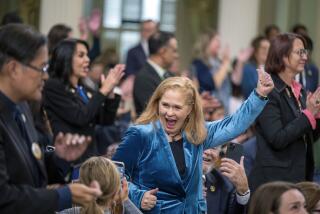Defects in Government Hobble Progress in State
Sacramento — The chief culprit in California’s Capitol is not a lollygagging Legislature or an inept governor. It is a system structured for stalemate.
That’s the real roadblock to delivering the goods for the public, and the cause of the politicians’ latest failure: their inability to negotiate a big public works bond for the June ballot.
True, plenty of mistakes were made, especially by Gov. Arnold Schwarzenegger. He got too grandiose and greedy by advocating a state bond package so massive -- $68 billion -- that it was unfathomable to legislators of his own party.
It didn’t improve the Republicans’ mood that the governor had recently named a career Democrat activist, Susan Kennedy, as his chief of staff.
As for Democrats, Senate and Assembly leaders couldn’t agree on a rebuilding plan. But, come to think of it, they’re not supposed to -- not until the end of the legislating process, after each house has passed its own bill and the two versions are merged. The Founders set up a two-house Legislature for checks and balances.
But California’s legislative system has become dreadfully flawed over the years. And these are three defects that relate directly to the failed effort on bonds:
* The two-thirds vote.
* Term limits.
* Egregious gerrymandering.
California’s requirement of a two-thirds majority vote in each house for practically any bill involving money -- the budget, tax hikes, general obligation bonds -- makes a mockery of democracy. It allows a one-third minority to block the majority will.
It’s the main reason why Sacramento lawmakers, representing an increasingly diverse citizenry, often are immobilized when confronted by the most important public policy questions.
Congress doesn’t face this two-thirds hurdle. Neither does the California state electorate. If it had, Proposition 13 -- the revered property tax cut -- never would have passed in 1978. Ironically, that initiative also imposed the two-thirds vote requirement for state tax increases.
Unlike for the budget and taxes, there is reasonable justification for requiring a two-thirds legislative vote to approve a long-term general obligation bond, the repayment of which is guaranteed by all state taxpayers. A supermajority vote should be required, it can be argued, before obligating the next generation to pay off current debt.
But my counter is that there are ample checks and balances. The bond has to pass both legislative houses, be signed by the governor and approved by voters statewide. That can be a grueling gauntlet.
This generation of politicians, including Schwarzenegger, worships Gov. Pat Brown -- “the great builder” -- and strives to be his disciples. Few realize, I suspect, that the crowning achievement of Brown’s career -- passage of a bond funding the lionized California Water Project -- was attained without a two-thirds legislative vote.
“They couldn’t have gotten a two-thirds vote,” recalls Ron Robie, a state appellate judge who, in that era, worked for the bond’s legislative coauthor and later became state water director.
Brown’s water plan passed the Legislature in 1959 when only a simple majority vote was needed to place a GO bond on the general election ballot. (For some reason, a two-thirds vote was needed for a primary ballot.)
Brown and some very skilled legislators used all their wiles to overcome north-south rivalries -- partisan politics wasn’t a factor -- and win passage in the Senate, 25-12, then the Assembly, 50-30. Voters narrowly passed it the next year.
In 1962, as part of a supposedly innocuous constitutional revision, the Legislature and electorate imposed a two-thirds vote requirement for all general obligation bonds.
Also at that election -- in another unfortunate constitutional streamlining -- a never-used but potentially valuable legislative tool was junked. Until then, a budget could be passed on a majority vote if spending didn’t rise above 5%.
Not only legislative tools have been scrapped, but also legislating experience. With it has gone the building of institutional pride and the motivation for long-range planning.
Expert, veteran committee chairs -- the kind needed to shape and push a water plan -- no longer exist because of term limits.
Weak house leaders have developed because they’re not in office long enough to cement power or gain the trust of fellow lawmakers. Increasingly, the four leaders have turned to “Big Five” negotiations with the governor, skirting the traditional committee process and upsetting ignored colleagues.
In the infrastructure bargaining, it was especially bad. Schwarzenegger often dealt directly with individual leaders. Nobody ever was quite sure where overall negotiations stood. Republicans especially complained that they were out of the loop.
It was all aggravated by the Legislature’s 2001 redrawing of its districts -- a textbook gerrymander that accomplished its purpose: protecting incumbents and the political status quo.
Few, if any, legislators need fear the wrath of voters in November for failing to deliver flood control, highway improvements or new classrooms. They’re looking at cinch reelections and can afford to be ideologues, rather than pragmatic problem solvers.
Democratic leaders last year promised their own redistricting reform if voters rejected the governor’s. Voters did and we’re waiting.
Assembly Speaker Fabian Nunez (D-Los Angeles) says he’s working on a plan: redistricting reform tied to term-limit relaxation.
Fine, get it on the November ballot. Along with the old majority-vote rules for the budget and bonds.
Not even the great Pat Brown could have maneuvered a big bond through this impassable maze.
George Skelton writes Monday and Thursday. Reach him at [email protected].
More to Read
Get the L.A. Times Politics newsletter
Deeply reported insights into legislation, politics and policy from Sacramento, Washington and beyond. In your inbox three times per week.
You may occasionally receive promotional content from the Los Angeles Times.











